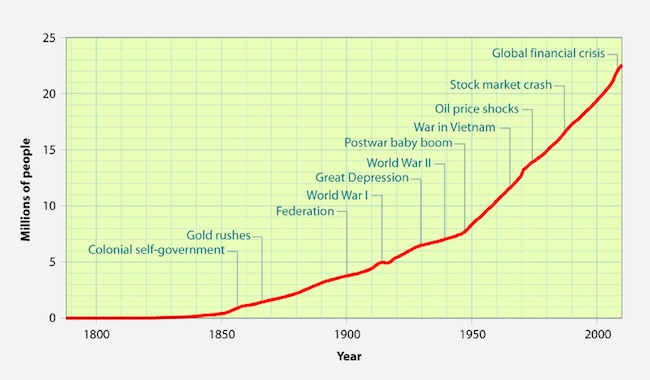Australia’s recent population surge has attracted attention from some influential quarters. [17 August 2010 | Peter Boyer]
Eons before Jesus and Solomon walked the earth, humans called Australia home. They were here tens of thousands of years before the last ice age held the world in its grip.
Apart from vegetation changes caused by repeated firing of bushland, the original Australians trod lightly upon the land. Early Europeans remarked how well they blended with the landscape.
Contrast that with modern Australians. Our big environmental footprint is seen as an outcome of technologies and economies that draw heavily on natural resources, but one other factor often gets overlooked: sheer weight of numbers.
The number of indigenous Australians when the First Fleet arrived at Port Jackson in 1788 has been estimated to be no more than 750,000, based on a calculation of the maximum sustainable population given the natural resources available to these non-agricultural nomadic people.
As Aboriginal numbers dropped, European immigrants arrived at an increasing rate. It took 170 years for the population to reach eight million, but only 40 years for that number to double. Today, Australia is home to around 30 times the number of people it held in 1788 — the figure calculated to be the “unimproved” continent’s carrying capacity.
It’s a success story, of sorts. We managed to “tame” our land with irrigation schemes watering vast food-producing acreages, and to find minerals underground, including the important ingredients of today’s wealth, coal and oil. We used the wealth to grow, and grow more.
The idea of growth has become a part of the fabric of our society. In the decades of plenty that followed World War II our lives have been dominated by the endless loop of more people feeding more consumption feeding a growing economy feeding more people… and so it goes on.
But our attitudes to resource extraction are changing. The mining boom is making some people lots of money, but “Quarry Australia” has tended to suck investment dollars out of genuine innovation. Meanwhile that other resource vision, “Foodbowl Australia”, is troubled by a shortage of water in the Murray-Darling basin, yet another reminder of the perils of pushing nature’s limits.
Politicians are shifting ground. In her first days as Prime Minister, Julia Gillard distanced herself from Kevin Rudd’s “big Australia” mindset by adding “sustainable” to the title of Tony Bourke’s population portfolio. In the present election campaign both sides of the main party divide are at last talking about our land’s capacity to feed us, and to question our rate of population growth.
The Liberal Party has routinely taken the position that a high population growth is good for business, but in one of those sudden turns that have become his trademark as Liberal leader, Tony Abbott announced a fortnight ago that he would restrict annual immigration to the average of the past 40 years — 1.4 per cent of the Australian population.
Enter the ubiquitous Dick Smith, aviator and former electronics retailer, who has started a campaign to limit the country’s population in a documentary screened last week on ABC TV.
In Dick Smith’s Population Puzzle, Smith said that he’d never thought much about the issue of population, both for Australia and the world, until his daughter Jenny put it to him that in all the talk about sustainability and climate action, this was the elephant in the room.
The hour-long show was a statistician’s delight. Australia’s population growth leads the world (last year 2.8 per cent or 480,000 — close to Tasmania’s total population). Two-thirds of the increase comes from immigrants; the rest are natural increase fuelled by the baby bonus. To accommodate the extra people, each year we need to build 300 new schools and recruit 1200 extra police.
The resultant housing shortage raises property prices, while also causing enormous pressure on food-producing lands around cities. To feed today’s population we need to produce two tonnes of food per hectare from available suitable land (6 per cent of Australia’s total land area). At current growth rates, by 2050 the demand will rise to around five tonnes per hectare.
Then there are our obligations to other countries. Australia takes people who’ve been trained cheaply in undeveloped countries, where they’re most needed, while neglecting training at home. Australia, says Smith, should look to its own training programs to meet our needs, cutting intake of skilled migrants while increasing humanitarian immigration.
Smith concluded that when all the factors are brought together — climate change, food, mouths to feed, housing and the rest — Australia is headed for a crash. “No-one is joining up the dots.”
Tony Jones’s Q&A show, screened after the documentary, revealed why we don’t talk much about population. This was as heated and personal a debate as you’ll ever see on public television.
Immigrants came out strongly against the Smith view, arguing that the world, including countries from which migrants come, benefits from a high immigration rate. Equally vocal in their opposition were business people, notably panellist John Elliott and Anthony Shepherd of Transfield Services.
Deep into an election campaign it was good to see politicians speaking in support of sustainable population policy. The Greens’ Bob Brown was more forthright than I’d heard him, but the real surprise was the thoughtful, bipartisan position of the two major party panellists — current minister Tony Bourke and the Liberals’ Scott Morrison.
It’s too early yet to claim any breakthrough on population policy, but maybe, just maybe, this might be the start of something big.

